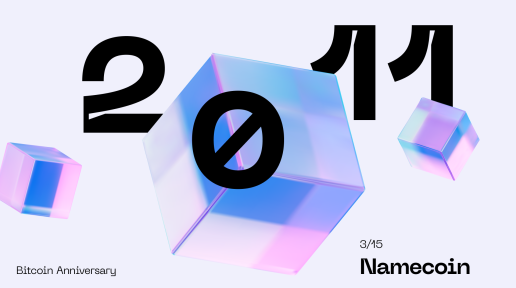After Bitcoin launched, blockchain enthusiasts began to understand how important this new cryptographic technology was for the future.
Soon, developers started thinking about how to create more use cases for blockchain technology. And since 2009, Bitcoin has inspired many thousands of new cryptocurrencies and blockchain protocols — starting with Namecoin.
How Did Namecoin Start and How Did Bitcoin Inspire NMC?
The goal of Namecoin was to create a decentralized domain name system for internet addresses. The pseudonymous developer Vincent Durham recognized that Bitcoin proved decentralized ledgers and databases are possible. This led him to extrapolate that the same principles could apply to domain name registration and management. At the time, all internet domains were still centralized under ICANN.
By forking Bitcoin's code and making some modifications, the Namecoin core developers created a service that allowed users to register .bit domain names. These new domains could be owned in a censorship-resistant and decentralized way.
As people realized the power of decentralized money, they also understood how important decentralized internet infrastructure would be. Digital money used on a centralized internet tech stack still violated the principles of sovereignty and permissionless technologies.
Namecoin didn’t just kickstart the wave of altcoins that would follow. It was also a precursor to Web3, decentralized identity (DID), and the rest of the decentralized web infrastructure that is being built today.
Why was Namecoin Innovative in 2011?
Namecoin introduced a decentralized domain name system (DNS) by placing it on a distributed ledger like Bitcoin. Namecoin allows users to register .bit domain names that point to websites, email addresses, or other resources.
This concept was revolutionary because of how completely centralized the web was in 2011 — and in many ways still is. With blockchain domains, no central authority or third party could control who owns internet addresses or charge eternal registration fees. It also provided more privacy for domain holders.
Decentralizing the registry also reduces the possibility of censorship. If website or email address owners place their domains on a distributed network, a single regulator like a government or big tech company cannot remove it.
To make this decentralization work, Namecoin combines proof-of-work mining with the domain name infrastructure we already use online. Miners validate domain name registrations and process transactions on the Namecoin blockchain. And the blockchain is the underlying database to map .bit domains to their associated assets.
This innovation that sprung from Bitcoin was one of the first compelling examples of how blockchain would be useful beyond currency. Namecoin brought control and ownership to internet addresses without relying on traditional DNS authorities like ICANN or domain registrars. This was quite revolutionary in 2011.
How Did Namecoin Lead the Way for Altcoins?
Namecoin was more than just a spinoff idea sparked by Bitcoin. It led the way to the rest of the crypto industry, including altcoins and Web3.
Today, “altcoins” are any cryptocurrency that is not Bitcoin. There are thousands of altcoins, and they make up a huge portion of the overall crypto market cap. Ethereum is one of the most well-known altcoins, but Namecoin was the first.
Soon after Namecoin emerged, more altcoins landed on the scene with many different uses.
- Litecoin launched in 2011 as a faster payments alternative to Bitcoin for things like retail transactions.
- Ripple launched in 2012 as a real-time gross settlement system for currency exchange and remittances.
- Ethereum went live in 2015 as a programmable blockchain for decentralized apps and smart contracts.
While each one has a different functionality and network protocol, what ties these early altcoins together is their expansion on the decentralized vision Bitcoin introduced.
Distributed ledgers, peer-to-peer networks, cryptographic security, and consensus mechanisms like mining can all be implemented in innumerable ways. From different types of money, to infrastructure, to simple memecoins, Bitcoin and Namecoin laid the cornerstones of the crypto industry.
What is the Altcoin Landscape Like Today?
The new horizons of Namecoin brought more talent and interest into the crypto space. Developers, companies, and investors all began to dream of what could be built. This first altcoin showed that crypto could have its own kind of Cambrian explosion.
However, as altcoins sprouted up everywhere, the market also fragmented as many implementations and protocols grew redundant. Now, with thousands and thousands of altcoins, many have very similar — or even identical — capabilities. And not every altcoin is as innovative or useful as Namecoin.
While Namecoin led the way for a vibrant ecosystem of blockchain protocols and platforms, it also opened the door for memecoins. This makes it even more confusing and risky for users to know which projects are legitimate or useful.
In the future, there could be some amount of consolidation around the altcoins that provide true value or utility. It’s also more important than ever to have strong developer communities behind successful projects.
Interoperability between chains is another innovation the crypto community is working quickly to make a reality. When user experience and overall usability becomes easier through interoperable blockchains, mass adoption can speed up.
For now, altcoins remain an important source of experimentation and innovation in the crypto world. While many failed or scam projects emerge every day, crypto optimists argue those risks are the cost of free and unrestricted innovation.
The Building Blocks of Web3
Bitcoin was the pioneer of decentralized digital currency and blockchain technology. It introduced groundbreaking technological concepts that have spread into cybersecurity, financial systems, internet infrastructure, ownership, and more.
Namecoin was a pivotal project in pushing blockchain forward beyond a single Bitcoin network to the entire crypto industry that exists today. It also changed how people think about domain registration, giving internet users true ownership over their digital addresses. In many ways, it paved the decentralized internet and decentralized identity landscape that we know today, both of which have become core to the Web3 ethos.
And that movement started with none other than Bitcoin.

